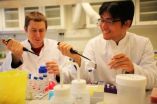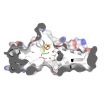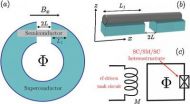(Press-News.org) The Sun blazes down from a deep blue sky – and rooftop solar cells convert this solar energy into electricity. Not all of it, however: Around a quarter of the Sun's spectrum is made up of infrared radiation which cannot be converted by standard solar cells – so this heat radiation is lost. One way to overcome this is to use black silicon, a material that absorbs nearly all of the sunlight that hits it, including infrared radiation, and converts it into electricity. But how is this material produced? "Black silicon is produced by irradiating standard silicon with femtosecond laser pulses under a sulfur containing atmosphere," explains Dr. Stefan Kontermann, who heads the Research group "Nanomaterials for Energy Conversion" within the Fraunhofer Project Group for Fiber Optical Sensor Systems at the Fraunhofer Institute for Telecommunications, Heinrich-Hertz-Institut, HHI. "This structures the surface and integrates sulfur atoms into the silicon lattice, making the treated material appear black." If manufacturers were to equip their solar cells with this black silicon, it would significantly boost the cells' efficiency by enabling them to utilize the full Sun spectrum.
Researchers at HHI have now managed to double the efficiency of black silicon solar cells – in other words, they have created cells that can produce more electricity from the infrared spectrum. "We achieved that by modifying the shape of the laser pulse we use to irradiate the silicon," says Kontermann. This enabled the scientists to solve a key problem of black silicon: In normal silicon, infrared light does not have enough energy to excite the electrons into the conduction band and convert them into electricity, but the sulfur incorporated in black silicon forms a kind of intermediate level. You can compare this to climbing a wall: The first time you fail because the wall is too high, but the second time you succeed in two steps by using an intermediate level. However, in sulfur this intermediate level not only enables electrons to climb the 'wall', it also works in reverse, enabling electrons from the conduction band to jump back via this intermediate level, which causes electricity to be lost once again. By modifying the laser pulse that drives the sulfur atoms into the atomic lattice, researchers can change the positions that these atoms adopt in the lattice and change the height of their 'levels', in other words their energy level. "We used the laser pulses to alter the embedded sulfur in order to maximize the number of electrons that can climb up while minimizing the number that can go back down," Kontermann sums up.
Prize-winning project
In the first stage of the project, the scientists modified the laser pulses and investigated how this changed the properties of black silicon and the efficiency of solar cells made from this material. Now they are working on using different shapes of laser pulses and analyzing how this changes the energy level of the sulfur. In the future, they hope that a system of algorithms will automatically identify how the laser pulse should be modified in order to achieve optimum efficiency. The 'Customized light pulses' project was one of this year's winners in the '365 Places in the Land of Ideas' competition; the awards ceremony is due to be held in Goslar on October 11, 2012.
The researchers have already successfully built prototypes of black silicon solar cells and their next step will be to try and merge these cells with commercial technology. "We hope to be able to increase the efficiency of commercial solar cells – which currently stands at approximately 17 percent – by one percent by combining them with black silicon," Kontermann says. Their starting point is a standard commercial solar cell: The experts simply remove the back cover and incorporate black silicon in part of the cell, thereby creating a tandem solar cell that contains both normal and black silicon. The researchers are also planning a spin-off: This will be used to market the laser system that manufacturers will be able to acquire to expand their existing solar cell production lines. Manufacturers would then be able to produce the black silicon themselves and include it in the cells as standard.
INFORMATION:
Solar cells made from black silicon
2012-10-09
ELSE PRESS RELEASES FROM THIS DATE:
LA BioMed's Dr. Bowen Chung delivering mental health care to troubled youths and adolescents
2012-10-09
LOS ANGELES (Oct. 9, 2012) – Approximately 14 percent of individuals suffering from depression and other mental health issues in the United States are minorities in underserved communities, yet very few medications or psychosocial interventions have been developed utilizing the participation of these groups. This year, Bowen Chung, M.D. - principal investigator at The Los Angeles Biomedical Research Institute at Harbor-UCLA Medical Center (LA BioMed) - will change that when two unique studies are initiated: the first study will utilize intervention that focuses on families ...
Secondary osteoporosis: More than what meets the eye!
2012-10-09
An SGH study has revealed that considering all osteoporotic patients as having simple osteoporosis and treating all of them alike by putting them on potent long term medication without finding out the cause of their osteoporosis may be ineffective and in most cases downright harmful.
Secondary osteoporosis is a rather common but lesser known type of osteoporosis that affects men and women of any age. It is caused by certain medical conditions that result in bone loss or interfere with development of peak bone mass. Contributors of secondary osteoporosis include conditions ...
Coffee speeds up return of bowel function after colon surgery
2012-10-09
Patients who drank coffee, rather than water, after bowel surgery to remove a part of their colon experienced a quicker return to bowel movements and tolerance of solid food.
Those are two of the key findings of a comparative study of 80 patients, carried out at University Hospital Heidelberg, Germany, and published in the surgical journal BJS.
"Post-operative bowel obstruction is a common problem after abdominal surgery and the aim of this study was to test our theory that coffee would help to alleviate this" says lead author Dr Sascha Müller, who is now based at ...
Glowing DNA invention points towards high speed disease detection
2012-10-09
Links to publications:
http://pubs.acs.org/doi/abs/10.1021/nn302633q
http://pubs.acs.org/doi/abs/10.1021/ac201903n
...
Mayo Clinic researchers stop neuromyelitis optica attacks with new therapy
2012-10-09
ROCHESTER, Minn. -- Mayo Clinic researchers have identified a new therapy for patients with neuromyelitis optica that appears to stop inflammation of the eye nerves and spinal cord. NMO is a debilitating central nervous system disorder that is often misdiagnosed as multiple sclerosis (MS). In the study, patients with severe symptoms of the disease, also known as NMO, were given eculizumab, a drug typically used to treat blood disorders.
While not a cure, the therapy Mayo Clinic researchers used in the study to halt attacks could potentially lead to longer attack-free ...
Dead stars could be the future of spacecraft navigation
2012-10-09
Scientists at the National Physical Laboratory (NPL) and the University of Leicester have been commissioned by the European Space Agency (ESA) to investigate the feasibility of using dead stars to navigate spacecraft in deep space. The findings of the research will advise ESA strategy and if feasible this technique may in future revolutionise the way spacecraft navigate in the outer Solar System and beyond.
Spacecraft navigation currently relies on radio transmissions between a distant craft and a network of ground-stations on Earth. This means that the craft has to ...
IspH -- a protein free to choose its partners
2012-10-09
This press release is available in German.
The iron-sulfur protein IspH plays a central role in the terpene metabolism of several pathogens. The mechanism of the reaction provides an approach for developing new antibiotics, particularly against malaria and tuberculosis. While researching this enzyme, biochemists at the Technische Universitat Munchen discovered a previously unknown reaction: IspH accepts two completely different classes of molecules as partners. This surprising insight, published in Nature Communications, opens up new perspectives in combating infectious ...
Scientists discover gene behind rare disorders
2012-10-09
Scientists at the Montreal Neurological Institute and Hospital – The Neuro, McGill University working with a team at Oxford University have uncovered the genetic defect underlying a group of rare genetic disorders.
Using a new technique that has revolutionized genetic studies, the teams determined that mutations in the RMND1 gene were responsible for severe neurodegenerative disorders, in two infants, ultimately leading to their early death. Although the teams' investigations dealt with an infant, their discovery also has implications for understanding the causes of ...
Chaperone protein subverts removal of glaucoma-causing protein
2012-10-09
Tampa, FL (Oct. 8, 2012) -- The chaperone protein Grp94 can interfere with the clearance of another protein known to cause the glaucoma when mutated, a new study led by researchers at the University of South Florida has found. Using a cell model, the researchers also demonstrated that a new specific inhibitor of Grp94 facilitates clearance of the genetically-defective protein, called myocilin, from cells.
Reported online this month in JBC (The Journal of Biological Chemistry), the discoveries could lead to a new treatment for some hereditary cases of glaucoma, an eye ...
Topological superconductors
2012-10-09
If quantum computers are ever going to perform all those expected feats of code-breaking and number crunching, then their component qubits---tiny ephemeral quantum cells held in a superposition of internal states---will have to be protected from intervention by the outside world. In other words, decoherence, the loss of the qubits' quantum integrity, has to be postponed. Now theoretical physicists at the Joint Quantum Institute (JQI) and the University of Maryland have done an important step forward to understand qubits in a real-world setup. In a new study they show, ...


